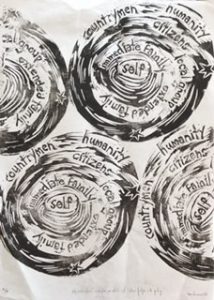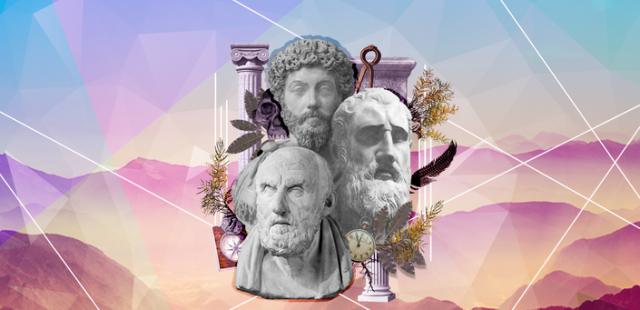
The following is a summary of the presentation Dr. Liz Gloyn provided at Stoicon-X London in 2017. Dr. Gloyn will also be presenting at Stoicon 2018 next month.
Stoicism argues that we are each responsible for our moral disposition and thus are fully in control of our own journey towards virtue. It is very much up to us to look at our failings and to seek to improve them by correcting any misunderstandings we might have about what virtue actually consists of; as such, a lot of Stoic activity involves frank introspection and asking ourselves hard questions about whether our conceits and affronts are in fact justified. That doesn’t mean that Stoicism never talks about how we, as individuals, should engage with other people. The Stoics have a lot to say about how the good Stoic disciple should be an active and engaged citizen, and also about how he should interact with other sages, or with non-sages whom he encounters. Yet one aspect of Stoic thought which tends to get overlooked is how the Stoic should interact with his family.
Much of the approach the Stoics advocate is based on their theory of oikeiōsis. The Stoics used this term to refer to two distinct processes which were clearly related to each other, but no surviving text explains the link. The first phase, what has been labelled personal oikeiōsis, happens when we are infants, and is when a child realises that the pink waving thing in front of her face is actually her hand. The second phase occurs once we have reached the age of reason – presumably somewhere around fourteen or fifteen – when we are able to start thinking about the relationship between us and other people.
To explain this process, the Stoic Hierocles used an image of concentric circles. He wrote that the smallest circle is the one that includes the individual and the individual alone; the second circle, which surrounds the first, contains immediate blood relatives; the third circle contains more distant relations, like grandparents, uncles and aunts; the fourth circle contains any remaining relatives. The circles continue, gradually expanding to include neighbours, then members of the same tribe, then inhabitants of the same city, until finally the circles encompass the whole human race.
The process of oikeiōsis is the way in which the aspiring Stoic begins to brings the interests of the people in each of the circles into the circle which contains the self, until ultimately the perfect sage thinks of the interests of all of humanity as being her own. Hierocles talks about the early stages of this process as being firmly rooted in the family. Indeed, the bond between a mother and her baby was often used to illustrate oikeiōsis at work, both in animals and in humans; the way that a mother immediately protects its offspring, often in self-sacrificing ways, was taken as evidence of stepping out of that first circle of the self, into the circle that includes children, and considering someone else’s best interests to be your own.
Hierocles constructs a very different model for understanding ancient family relationships to the conventional ones we might be more familiar with. The normal structure of the ancient Roman family was very strongly hierarchical. At the top of the structure was the paterfamilias, the oldest male in the bloodline; that could be your father, grandfather, uncle or great-uncle, or perhaps even your older brother. The paterfamilias had absolute authority, including the right of life and death, over everyone in his familia, which included everyone related by paternal bloodline, as well as any wives who had married into the familia and any slaves belonging to the household.
Hierocles’ model breaks that hierarchical structure down completely. The first circle beyond the self includes parents, siblings, your spouse and your children, in a subtle significant rearrangement of relationships. First of all, the father is taken down from his pedestal and put on the same level as the mother. Second, rather than simply reproducing the hierarchy with one’s parents at the top of the pile, the model completely abandons a top-down approach, and sees parents as standing in the same relation to us as our siblings, spouse and children. We might have seen our siblings and spouse as being vaguely equal, as they are more likely to belong to our age cohort, but Stoic theory challenges us to move away from thinking about our other family relationships in a vertical way.
Perhaps the easiest way to think about how this model changes our relationship to the family comes from thinking about the role that they are supposed to play in our lives, not just as authoritarian disciplinarians, but as ethical role models. The Romans generally expected fathers to be the benchmark by which their sons would measure themselves, and that mothers would police their sons’ more outrageous behaviour, but saw ethics as a fundamentally civil activity, concerned with producing good citizens, in contrast to the internal focus that Stoicism encourages in its adherents.
Marcus Aurelius puts the various qualities he’s inherited from his family at the front of the Meditations:
From my grandfather Verus I learned good morals and the government of my temper.
From the reputation and remembrance of my father, modesty and a manly character.
From my mother, piety and beneficence, and abstinence, not only from evil deeds, but even from evil thoughts; and further, simplicity in my way of living, far removed from the habits of the rich.
From my great-grandfather, not to have frequented public schools, and to have had good teachers at home, and to know that on such things a man should spend liberally. (Meditations 1, trans. George Long)
That he chooses to open the work with a list of these moral legacies, rather than with (for instance) a family biography, signals that the influence of the family on his moral development has been significant and deserves to have pride of place in the story that he wants the Meditations to tell. If you only read the first page of the Meditations, you will know that he feels debts of gratitude not only to his grandfather and great-grandfather, and indirectly his father, but also to his mother.
Indeed, he says that his mother taught him by her example about not only avoiding evil deeds but even contemplating them – such things simply did not occur to her. To be so in tune with virtue that the opportunity for vicious behaviour never comes to mind is surely what the Stoics would consider one mark of the perfect sage. Equally, simplicity in living is another mark of sage-like behaviour, not to be too attached to the trappings of wealth – although Marcus Aurelius’ definition of a modest lifestyle might not have matched up to the modest lifestyles of his citizens.
Mothers might act not just as models for their sons, but also as companions along the moral journey, further illustrating the Stoic challenge to the assumption of hierarchy in family relationships. In his Consolation to Helvia, Seneca writes a short speech that he imagines his mother Helvia saying as she grieves over his absence in exile, outlining the various elements of their relationship that she misses:
Therefore I am without the embrace of my most dear son; I cannot enjoy the sight of him or his conversation. Where is he, at whose appearance I relaxed my sad face, in whom I lay all my worries down? Where are the conversations which I could not have enough of? Where are the studies in which I took part more happily than a woman, more intimately than a mother? Where is that encounter? Where is that always boyish cheerfulness at seeing his mother? (Consolation to Helvia 15.1, trans. Liz Gloyn)
Alongside missing his smile and his delight in seeing her, Helvia also misses her son’s conversation and their shared studies. As the rest of Seneca’s advice to Helvia makes clear, the subject in question is philosophical – he encourages her to continue with her study of philosophy in order to give her true comfort in her situation. The implication is that Seneca and his mother have been working together on reading and talking about Stoicism, as a shared and mutually enjoyable endeavour. Rather than the parent funnelling down moral knowledge to the child, in a supposedly infallible way, Helvia and Seneca have been partners in the question of ethical exploration; the rigid hierarchy of a relationship based on age has been abandoned.
In part, this is because of Seneca’s own maturation as a rational adult – I am not suggesting the Stoics think this is an appropriate way to parent an eight year old. But the challenge to unquestioned parental authority, and the call to operate through mutual enquiry, seems to be the underlying premise of the relationship here.
These are just snippets of the things that the Stoics have to say about the family. The issue is that the family can often get eclipsed by other things – by the focus on the individual, or by other theories and ideas. But if a Stoic disciple is serious about living a life which is fully consistent with Stoic principles, then she must always apply them consistently – and that includes in her dealings with her family.
Liz Gloyn is Senior Lecturer in Classics at Royal Holloway, University of London. She is the author of The Ethics of the Family in Seneca. You can find her blog at Classically Inclined



